
The technology surrounding medical data has caused a transformational shift in healthcare over the years. The systems used to make this change have a lot to contend with. They need to accurately record and relay patient data to physicians, hospitals, other healthcare providers and insurance companies while adhering to patient privacy regulations. Multiply this by the millions of people seeking care and the complex nature and variety of health issues patients face, and you get an unbelievably complex stream of information to wrangle.
Now add in the incredible potential of all this medical information in terms of research—data that could help us discover cures, notice disparities and create solutions. Accurate and reliable health data is a goldmine of potential, but without standardization and data analysis, all that value stays buried in the murk of confusion—and the sheer, overwhelming volume of details.
Let’s pretend you go to your doctor’s appointment with severe pain in your abdomen. After a short examination, the physician realizes you are experiencing appendicitis. The doctor immediately sends you to a hospital for an appendectomy to remove your appendix. Afterward, you stay at the hospital for a few days to recover and then go home. But now, your clinic and hospital need payment for the exact procedure, medications and examinations they provided.
And any future medical professionals you see, even if you move to a new country, need to know about your procedure and which treatments you received.
Did the first clinic perform any tests? What type of examination led to the appendicitis diagnosis? Which type of appendectomy did you undergo? What type of anesthesia did the hospital team use? What suturing was necessary afterward? Which medications did you receive during recovery? Did anything need adjusting? All these details need to be accurate for correct billing and for the best future care.
This information can be standardized to a code that your insurance company could understand and index as quickly as a hospital on the other side of the world. This could lead to you having a higher chance of getting an accurate insurance report, your future healthcare providers having a higher chance of understanding your medical history and researchers (when permitted) having a better chance to understand impacts of appendectomies, anesthesia, medications and more.
Increased accuracy, efficiency and understanding—this is the hope of CPT and other medical coding systems.
If you are interested, keep reading! We will break down some of the most common questions around CPT codes to help you understand how they work.
What are CPT codes?
CPT stands for Current Procedural Terminology, a medical coding categorization system that focuses on services offered by healthcare providers. These codes are five-digit numbers assigned to each task and service a healthcare provider could perform during a visit. When new procedures and needs appear, the CPT Editorial Panel evaluates and creates new codes to fit the situation. According to the AMA (American Medical Association®), this process ensures clinically valid codes get regular updates to reflect current clinical practice and innovation in medicine.1
There are four different categories of CPT codes that different groups can choose to utilize based on what they want to report. The AMA lists these categories as:
Category I: These are codes for a procedure or service. Codes range from 00100–99499 and are generally ordered into sub-categories based on procedure/service type and anatomy.
Category II: This includes optional alphanumeric tracking codes you can use for performance measurement.
Category III: These temporary alphanumeric codes are for new and developing technology, procedures and services. They are used for data collection, assessment and in some instances, payment of new services and procedures that aren’t yet in Category I.
Proprietary Laboratory Analyses (PLA) codes: These are codes for proprietary clinical laboratory analyses from a single lab or multiple FDA-approved labs. This category includes Advanced Diagnostic Laboratory Tests (ADLTs) and Clinical Diagnostic Laboratory Tests (CDLTs).
What’s the difference between ICD and CPT codes?
Believe it or not, CPT codes represent just a fraction of the healthcare information generated by a patient visit. Medical coding professionals also work with International Classification of Diseases (ICD) codes when processing patient information.
So what’s the difference between ICD and CPT codes?
CPT codes are focused on the specific treatments and services offered by a healthcare provider. For example, sutures, diagnostic images, blood tests and anesthesia would all fall under this categorization. ICD codes are focused on the other side of the coin—categorizing the specific ailments and circumstances that lead to the visit. For example, concussion with loss of consciousness, glaucoma, broken femur, burns and more are all categorized by ICD codes.
Pair these codes together in a file, and you can easily see the health issues a patient is facing and the steps taken during a visit to address them.
Are CPT codes used internationally?
Part of the dream in healthcare data is using coding systems to provide standardized information that’s not limited to geographical borders. While global alignment is a huge undertaking that’s yet to be accomplished, CPT codes are used in 40 different countries thus far.2 As more countries adopt this system of standard reporting, the hope is that operational efficiency and cross-border collaboration to address chronic healthcare problems will increase.
How do medical coders use CPT codes?
Medical coders will most likely work with Category I CPT codes since these codes represent the bulk of services a healthcare system can provide. The CPT codebook has many different layers of organization, and the more you understand that system, the easier it will be to find and enter the correct codes for what you need.
For example, code numbers are in sections based on the field of service they fit. The American Academy of Professional Coders® offers the following breakdown of CPT code sections: 3
- Evaluation & Management (99202–99499)
- Anesthesia (00100–01999)
- Surgery (10021–69990)
- Radiology Procedures (70010–79999)
- Pathology and Laboratory Procedures (80047–89398)
- Medicine Services and Procedures (90281–99607)
Medical coders will receive information from the healthcare provider about which procedures or services they gave a patient. Then, the medical coder uses the CPT codebook to find and enter the correct code.
While that might sound straightforward in theory, this can be challenging in practice. Since healthcare is complex, there are a lot of variables medical coders need to be aware of and account for. For example, both ICD codes and CPT codes both utilize indentations to show that the indented item is a critical variation on the procedure above it and needs to replace the above code.
What is a CPT modifier in medical billing?
Another layer of CPT coding is expressed in modifiers. Modifiers are two-character additions that medical coders can attach to the code, which represent a variation or unique circumstance to the existing code. The modifiers are important because they represent unusual or nuanced circumstances that can alter a procedure without needing to create a completely new CPT code.
For example, maybe a patient received a service, but due to a complication, needed to be moved to a separate facility partway through. CPT code modifiers can indicate that multiple locations were involved in an otherwise standard procedure.
Other scenarios where modifiers matter, according to the AAPC, are when a service was increased or lessened compared to what is typical, when there were multiple providers or when the service or procedure was performed more than once.
How to find CPT codes in my explanation of benefits (EOB)?
If you visit your doctor, a hospital or any healthcare facility and receive documentation about your visit, you can take a look at the CPT codes that apply to your treatment. A typical explanation of benefits will list the itemized services you received, followed by a code in parenthesis.
It might look something like this:
Date Provider Description of service (#####)
That number in parenthesis next to your description of service is the CPT code.
CPT codes are only one part of medical coding
Medical coding is a fascinating field that helps ensure the flow of crucial information across our healthcare system. As coders work to keep health information accurate and accessible to the necessary parties, patients can receive better care, providers can identify and cut down on waste, and researchers can tap into health information to guide the development of new procedures, treatments and more.
Want to learn more about the important work of medical coders and health information professionals? Check out “What Is a Medical Coder? An Easy Explanation.”
Related Articles:
1“CPT overview and code approval,” American Medical Association®, [accessed July 2022], https://www.ama-assn.org/practice-management/cpt/cpt-overview-and-code-approval.
2“The Language of Medicine Today. The Code to Its Future,” American Medical Association and CPT International, [accessed July 2022], https://cpt-international.ama-assn.org/.
3“What Is CPT?” American Academy of Professional Coders, [accessed July 2022], https://www.aapc.com/resources/medical-coding/cpt.aspx.
CPT and American Medical Association are registered trademarks of the American Medical Association.
American Academy of Professional Coders is a registered trademark of American Academy Holdings, LLC.




